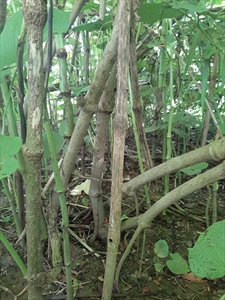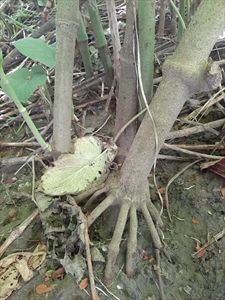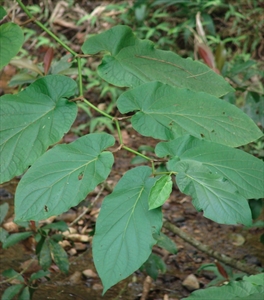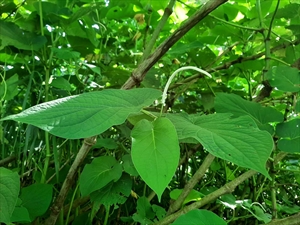False kava. It is also known as hoja santa (Spanish for 'sacred leaf'), spiked pepper, root beer plant.
Pacific Pests, Pathogens, Weeds & Pesticides - Online edition
Pacific Pests, Pathogens, Weeds & Pesticides
False kava (492)
Piper auritum. It is a member of the Piperaceae.
Asia, North (Florida, Hawaii), South and Central America, the Caribbean, Oceania. Not present in Africa. It is recorded from Federated States of Micronesia, Fiji, French Polynesia, Samoa, Tonga, and Vanuatu. It is a native of Central America, and northern South America (Mexico to Colombia).
A major invasive plant, rapidly forming dense thickets through suckering, competing successfully with native vegetation in forests, along waterways, food gardens (along with true kava, Piper methysticum), plantations, and pastures (Photos 1&2). Difficult to control. Stem, root and rhizome pieces regrow easily. In its native habitat, false kava is an early coloniser of partly shaded forests, forest edges, and disturbed lands; it does not favour dense shade. It is found from sea level to 900 masl., sometimes to 1500 m.
A perennial shrub, 1-2 m, with single stems, often supported by prop roots; sometimes becoming tree-like up to 6 m (Photos 3&4). Leaves, broadly oval, 30 cm long, up to 20 cm wide, pointed at the tip, with two deep lobes at the base (leaf-stalk end) - one lobe noticeably larger, and margins with dense, short white hairs (Photos 5-7). Leaf stalks with wings surrounding the stem. Flowers, small, pale green, tightly packed in long, slender arching (or drooping) spikes, 10-25 cm long and 3-5 mm thick, produced opposite the leaves (Photos 7&8). Fruits, less than 1 mm.
The straight spike of flowers and the winged leaf stalks distinguish false kava from spiked pepper, Piper aduncum (see Fact Sheet no. 493).
Spread is by birds, bats and rodents and, possibly, plant parts in water. Long-distance spread is associated with the contamination of consignments of true kava, Piper methysticum, traded internationally to alleviate anxiety.
False kava grows much faster outcompetes true kava, Piper methysticum. CABI suggests that false kava is a host of Cucumber mosaic virus, the cause of kava dieback (see Fact Sheet no. 160). Perhaps the greatest impact is the contamination of kava with false kava, which lowers the quality and hence value of traded kava. False kava contains safrole, classified as a carcinogen in the USA and Europe.
Its spicy leaves are used for their flavour in food and drinks; they are wraps for fish and meat dishes, added to soups and stews, and the tender shoots eaten in salads. The plant contains safrole which gives root beer its spicy taste. There are also many medicinal uses: teas and poultices from all parts of the plant for aches, pains, cramps, fevers, wounds, and much more. False kava is planted in gardens for its foliage and fragrant scent.
BIOSECURITY
Countries not yet infested by false kava should consider all likely pathways for entry, and apply quarantine measures accordingly. Particular attention should be given to its spread in consignments of true kava.
BIOLOGICAL CONTROL
Not a method recommended for false kava.
CULTURAL CONTROL
- Physical & Mechanical:
- Hand-pulling is possible, but can make the situation worse if roots remain as they will sprout to form new plants.
- Slash and burn thickets. Cuttings should not be left on site as they will regrow, as will rhizomes and roots. All should be collected and burned.
CHEMICAL CONTROL
Use systemic herbicides, such as triclopyr, 2,4-D, or imazapyr, applied to the basal bark or cut stems, about 15 cm above ground level, and spray immediately with herbicide. Check for regrowth.
____________________
When using a pesticide, always wear protective clothing and follow the instructions on the product label, such as dosage, timing of application, and pre-harvest interval. Recommendations will vary with the crop and system of cultivation. Expert advice on the most appropriate herbicides to use should always be sought from local agricultural authorities.
AUTHOR Grahame Jackson & Mani Mua
Information from CABI (2019) Piper auritum. Invasive Species Compendium. (https://www.cabi.org/isc/datasheet/41359); and Chaney A (2019) Piper auritum. Center for Latin American Studies. Vanderbilt University. (https://as.vanderbilt.edu/clas/piper-auritum/); and from Piper auritum Kunth, Piperaceae (2010) Pacific Islands Ecosystems at Risk (PIER). (http://www.hear.org/pier/species/piper_auritum.htm). Photo 1 Konrad Engelburger Pohnpei, Federated States of Micronesia. Photos 5&6 Forest & Kim Starr (2002) Piper auritum (habit). Location: Maui, Nahiku.
Produced with support from the Australian Centre for International Agricultural Research under project HORT/2016/185: Responding to emerging pest and disease threats to horticulture in the Pacific islands, implemented by the University of Queensland and the Secretariat of the Pacific Community.











